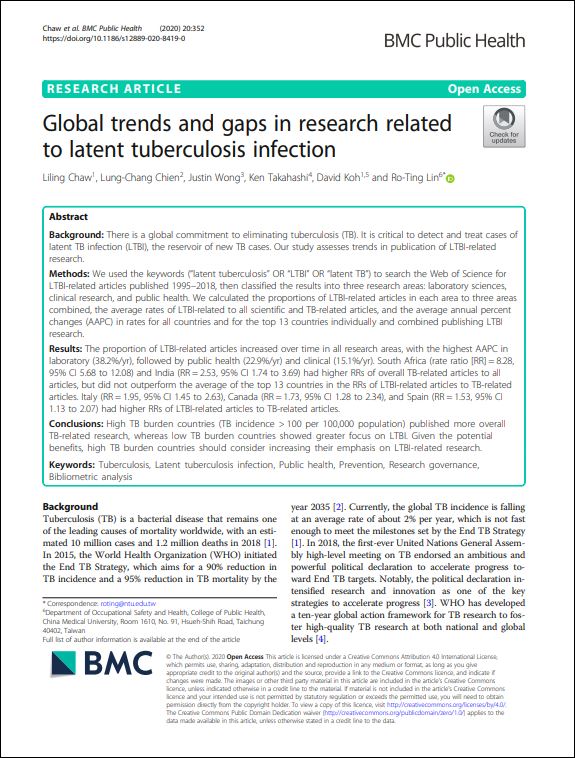Global trends and gaps in research related to latent tuberculosis infection

Citation: Chaw, L., Chien, LC., Wong, J. et al. Global trends and gaps in research related to latent tuberculosis infection. BMC Public Health 20,352 (2020). https://doi.org/10.1186/s12889-020-8419-0
Abstract: Background
There is a global commitment to eliminating tuberculosis (TB). It is critical to detect and treat cases of latent TB infection (LTBI), the reservoir of new TB cases. Our study assesses trends in publication of LTBI-related research.
Methods
We used the keywords (“latent tuberculosis” OR “LTBI” OR “latent TB”) to search the Web of Science for LTBI-related articles published 1995–2018, then classified the results into three research areas: laboratory sciences, clinical research, and public health. We calculated the proportions of LTBI-related articles in each area to three areas combined, the average rates of LTBI-related to all scientific and TB-related articles, and the average annual percent changes (AAPC) in rates for all countries and for the top 13 countries individually and combined publishing LTBI research.
Results
The proportion of LTBI-related articles increased over time in all research areas, with the highest AAPC in laboratory (38.2%/yr), followed by public health (22.9%/yr) and clinical (15.1%/yr). South Africa (rate ratio [RR] = 8.28, 95% CI 5.68 to 12.08) and India (RR = 2.53, 95% CI 1.74 to 3.69) had higher RRs of overall TB-related articles to all articles, but did not outperform the average of the top 13 countries in the RRs of LTBI-related articles to TB-related articles. Italy (RR = 1.95, 95% CI 1.45 to 2.63), Canada (RR = 1.73, 95% CI 1.28 to 2.34), and Spain (RR = 1.53, 95% CI 1.13 to 2.07) had higher RRs of LTBI-related articles to TB-related articles.
Conclusions
High TB burden countries (TB incidence > 100 per 100,000 population) published more overall TB-related research, whereas low TB burden countries showed greater focus on LTBI. Given the potential benefits, high TB burden countries should consider increasing their emphasis on LTBI-related research.
There is a global commitment to eliminating tuberculosis (TB). It is critical to detect and treat cases of latent TB infection (LTBI), the reservoir of new TB cases. Our study assesses trends in publication of LTBI-related research.
Methods
We used the keywords (“latent tuberculosis” OR “LTBI” OR “latent TB”) to search the Web of Science for LTBI-related articles published 1995–2018, then classified the results into three research areas: laboratory sciences, clinical research, and public health. We calculated the proportions of LTBI-related articles in each area to three areas combined, the average rates of LTBI-related to all scientific and TB-related articles, and the average annual percent changes (AAPC) in rates for all countries and for the top 13 countries individually and combined publishing LTBI research.
Results
The proportion of LTBI-related articles increased over time in all research areas, with the highest AAPC in laboratory (38.2%/yr), followed by public health (22.9%/yr) and clinical (15.1%/yr). South Africa (rate ratio [RR] = 8.28, 95% CI 5.68 to 12.08) and India (RR = 2.53, 95% CI 1.74 to 3.69) had higher RRs of overall TB-related articles to all articles, but did not outperform the average of the top 13 countries in the RRs of LTBI-related articles to TB-related articles. Italy (RR = 1.95, 95% CI 1.45 to 2.63), Canada (RR = 1.73, 95% CI 1.28 to 2.34), and Spain (RR = 1.53, 95% CI 1.13 to 2.07) had higher RRs of LTBI-related articles to TB-related articles.
Conclusions
High TB burden countries (TB incidence > 100 per 100,000 population) published more overall TB-related research, whereas low TB burden countries showed greater focus on LTBI. Given the potential benefits, high TB burden countries should consider increasing their emphasis on LTBI-related research.
Author(s): Liling Chaw, Lung-Chang, Justin Wong, Ken Takahashi, David Koh, and Ro-Ting Lin
Year: 2020
Language: English
Resource Type: Journal Articles
Source: Other
